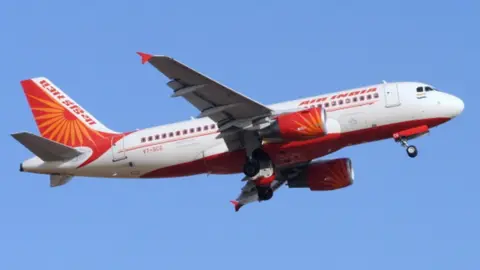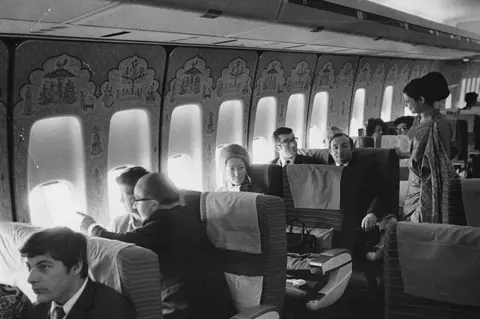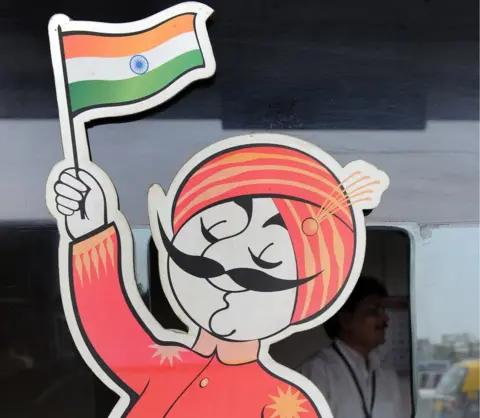Air India: Struggling national carrier sold to Tata Sons
 AFP
AFPIndia's loss making national carrier Air India has been sold to the Tata group, the country's largest conglomerate.
The government has sold the airline to the company, which was the highest bidder at nearly $2.4bn (£1.7bn).
The Tata group originally founded the airline in 1932 before it was taken over by the government in 1953.
The government had for years been trying to sell the airline, which has racked up losses worth $9.5bn.
But it recently sweetened the deal by making the terms of the debt less onerous for the buyer. It's still unclear how much debt the Tata group will take on under the new terms.
Minutes after the acquisition, Tata Sons Chairman Emeritus Ratan Tata tweeted a photograph of the firm's former chairman JRD Tata on the tarmac with an Air India plane in the background:
Allow X content?

The sale is a boost to Prime Minister Narendra Modi who had been keen to sell the government's entire interest in the airline.
Air India has many assets, including prized slots at London's Heathrow airport, a fleet of more than 130 planes and thousands of trained pilots and crew.
Tata Sons already run two airlines in India - Vistara, a full service carrier in partnership with Singapore Airlines, and AirAsia India, a budget airline in partnership with Malaysia AirAsiaBhd.
Why was Air India put on the block?
The national carrier had been making losses since it merged with the state-owned domestic operator Indian Airlines in 2007 and relied on taxpayer-funded bailouts to stay operational. The government said it was making a loss of nearly 200m rupees ($2.6m) every day to run the airline.
Over the years, the airline blamed high aviation fuel prices, high airport usage charges, competition from low-cost carriers, weakening of the rupee, as well as a high interest burden for its poor financial performance.
Air India "suffered for its inconsistent service standards, low aircraft utilisation, dismal on-time performance, antiquated productivity norms, lack of revenue generation skills and unsatisfactory public perception", according to Jitender Bhargava, a former executive director of the airline.
Were attempts made to sell Air India in the past?
In 2001, a previous BJP-led government tried to sell 40% of the stake.
A number of foreign airlines, including Lufthansa, British Airways and Singapore Airlines evinced interest, but withdrew when the government made it mandatory for them to partner with an Indian company to make a bid.
In 2018, Mr Modi's government tried to sell 76% stake and a portion of its debt, but potential buyers found the terms unattractive.
 D Chakraverty
D ChakravertyIn January 2020, the government decided to sell its entire stake in Air India. "There is no choice, we either privatise or we close the airline," Civil Aviation Minister Hardeep Singh Puri said.
By the end of December last year, Air India received two bids - one from Tata Sons and the other from a group of its employees and a US-based investment firm, Interrups.
In September, Ajay Singh, who runs the private budget airline SpiceJet, also bid for the airline in his personal capacity.
This time, the government decided to offload its entire stake in Air India, its low-cost arm Air India Express and ground holding subsidiary AISATS.
Experts say restructuring Air India's employee base of 13,000 plus people could be a challenge for the new owners.
Why does Air India remain attractive?
Apart from its fleet of over 130 aircraft, the new buyer will now have control of the airline's 4,400 domestic and 1,800 international landing and parking slots at domestic airports, as well as 900 slots at airports overseas.
More than two-thirds of the airline's revenues come from its international operations.
Air India also owns millions of dollars worth of prime real estate. According to the aviation ministry, its fixed assets - land, buildings, planes - in March last year were worth more than 450bn rupees ($6bn).
The airline also has more than 40,000 pieces of art and collectibles, including an ashtray designed and gifted by Spanish surrealist artist Salvador Dali. In return the airline had gifted Dali a baby elephant, which was flown to Spain.
With India seeing passenger growth of around 20% per year and analysts saying the Indian market is vastly underserved - Air India is a good prospect for Tata Group, say experts.

The journey of Air India
 Getty Images
Getty Images- 1932: Tata Sons, helmed by business tycoon JRD Tata, launches Tata Airlines
- 1946: It becomes a public company and is renamed Air India
- 1948: The government of India acquires a 49% stake in the carrier
- 1953: The government nationalises Air India
- 2007: Air India merges with Indian Airlines, a government-owned airline which only operated domestic routes
- 2007-08: Air India posts a net loss of 334m rupees ($4.6m; £3.5m)
- 2018: An attempt to sell a 76% stake in the airline attracts no bidders
- 2019: Air India posts a net loss of 12.8bn rupees, its highest since the merger in 2007

